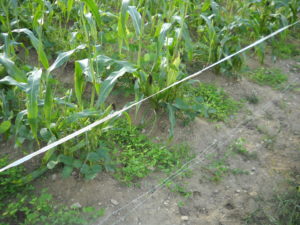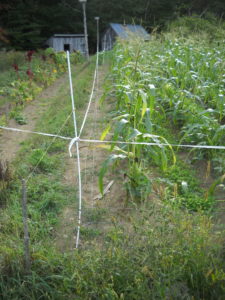By Will Bonsall
Note: Certified organic producers should check with their certifier before using any pesticides (including pest repellents) not mentioned on their organic farm plan. When using pesticides on crops grown commercially and intended for human consumption, an applicator’s license may be required. See https://www.maine.gov/dacf/php/pesticides/applicators/licensing.html.
One of the main problems with growing the foods we love is that other critters love them just as much as we do. In my article “Controlling Pest Insects in the Organic Garden” in the fall 2020 issue of The Maine Organic Farmer & Gardener, I discussed remedies for insect attacks. But what about bigger pests – the furry and the feathered ones? While mammals and birds tend to be far fewer in numbers, a single individual can do far more damage. In one night, a single deer can wipe out more kale than a whole army of cabbage worms. Fortunately, the larger critters are often easier to deter.
Shooting, trapping and poisoning are undeniably effective. A complication for me is that I’m a vegan. Oh, I certainly will kill things before going hungry myself, but I always prefer to use less lethal strategies – not only out of kindliness but also because these strategies often bring collateral damage. If I set out poison for mice, how will this affect the foxes, weasels and skunks that eat the dead mice? I care very much for those (non-vegan) predators who keep my competitors in check. After all, it is my fellow vegans in the world (i.e., potato bugs, woodchucks and deer) whom I cannot abide, since we’re after the same stuff. As I don’t keep chickens, predators are not a concern; I rather welcome them. Whenever I can, I greatly prefer to exclude or deter the pests rather than destroy them.
Live Animal Traps
A popular strategy for many compassionate gardeners is live-trapping. While I have and use several Havahart traps, I’m also skeptical of them. With live-trapping, the underlying assumption is that you remove the offending animal and release them somewhere where they’re not a nuisance. But where, pray tell, is that? My town has enough gardens scattered around that it is increasingly hard to find a release point where I’m not merely foisting my problem onto someone else. Even if I’m willing to drive far enough afield to find a wilder area, am I really doing the trapped animal a favor? Wildlife scientists claim that at any given time any habitat is probably filled to carrying capacity, and an interloper is likely to be attacked and dispatched by the habitat’s current residents (who already know the territory and its resources much better than an intruder). I will point out that wildlife populations are very un-static and that surplus animals are always roaming around seeking new territory, even without my dumping of captives there. At least then the animals have a chance, which is surely better than my summarily executing them. So while trap-and-release is no panacea, it has its place (assuming you can get the critter to go into the trap).


Physical Barriers
What I find more effective than live-trapping is excluding large pests through physical means. Row cover such as Reemay can be very effective against large browsers – provided you secure it well at the base so woodchucks, raccoons and birds don’t work their way underneath. I generally dislike using petroleum-based materials when they’re only good for one season. I haven’t bought any new row cover for years, but I have accumulated lots of old pieces which are torn and generally considered useless, though not to me. A ripped section may not stop cabbage moths, but it will discourage a deer, and even woodchucks don’t like it. An imperfect cover will likewise keep birds out of your strawberries, though some may find their way in and become trapped.
I’ve also found string to be very effective in different situations. When crows and wild turkeys were wiping out my newly planted corn seed, I stretched a length of twine right over the row, a foot or two above the ground. While the birds could very easily reach under it, they seemingly felt uncomfortable with the twine over their heads. Moreover, string will interfere with a bird’s ability to quickly takeoff if panicked. For extra effectiveness, especially with wild turkeys, I place strings at different heights: one row 2 feet high and the next row about 3 feet high. While cheap, string is a slight nuisance and still doesn’t deter voles or cutworms, so I’ve taken to starting most of my corn (and sunflowers and amaranth) in 72-cell seedling trays, three seeds per cell.
For very small areas like a single garden bed, I’ve been surprised at how a single string seems to exclude deer – especially at night. I place stakes surrounding the small plot and stretch string taut between them, no more than 40 inches off the ground. Obviously deer could step right over it; someone has suggested that the feel of the barely visible filament against the deer’s sides feels spooky to them. I don’t know about that, but I do know that when you enlarge the enclosure string ceases to work.
Hex wire fencing can be used to keep deer out of small areas as well. It also works to deter raccoons from corn if you take this precaution: Staple the wire to sturdy posts around your plot but leave the top foot or so of wire loose, snipping the corners so it remains floppy. Raccoons will fall when trying to climb it. Electrifying that fence is really effective; use insulators and keep the bottom edge of the wire 6 inches above the ground. If you’re going to use electric wire anyway, you can skip the fencing and just use two bare wires: one 6 inches high and the other 12-14 inches high. I usually use fiberglass rods with spring clips, which are easy to adjust to the perfect height. A simple 6-volt battery will not work unless you also use a fence charger to dam up the current and send it out in little 5,000-volt pulses – not lethal but very deterring. To deter both deer and raccoons with the same system, I add deer tape at a height of 40 inches to the same fiberglass rods as the double coon wire.
Repellents
One hears about bars of soap, sweaty shirts or balls of human hair, as well as various noise makers, radios and lights, for keeping animal pests away from the garden. My own experience is that any and all of those things work for a little while, but in time most critters get accustomed to them. It’s good to have a plan B or to simply rotate these strategies, so they never get used to one.
There are commercially available products which repel animals due to an unpleasant smell or taste, although some need to be reapplied after heavy rains. If they cover a large enough area, they might be worth the price. I’ve heard that with some products you can merely spray the ground around your garden to prevent critters from venturing further. Though generally harmless, produce should be washed thoroughly at harvest to remove any detectable residue.
A remedy which I’ve read about and intend to try soon is solar-powered ultrasonic transmitters. They are supposed to repel all kinds of animals, and I can supposedly tweak the frequency so I can keep out deer without offending my skunk, fox and weasel friends. The system could be quite pricey as most plots would require several transmitters for adequate coverage, but maybe that’s acceptable if they last a long time.
About the author: Will Bonsall lives in Industry, Maine, where he directs Scatterseed Project, a seed-saving enterprise. He is the author of “Will Bonsall’s Essential Guide to Radical Self-Reliant Gardening” (Chelsea Green, 2015). And indeed, he is also a distant cousin of another exemplary Maine horticulturist: Tom Vigue. You can contact Will at [email protected].
